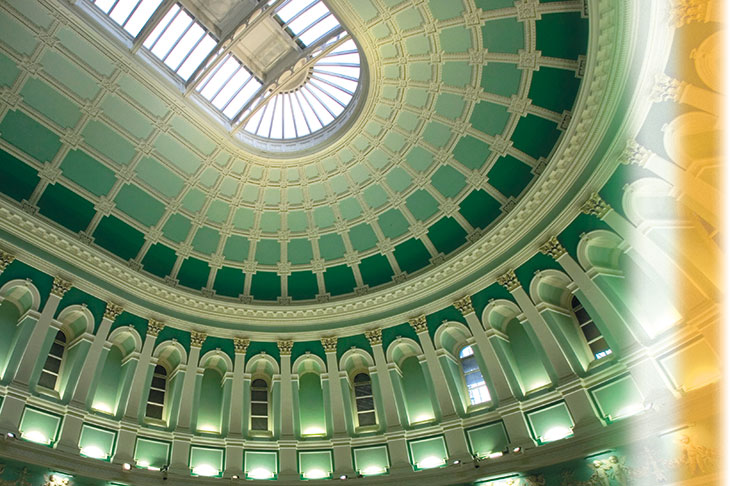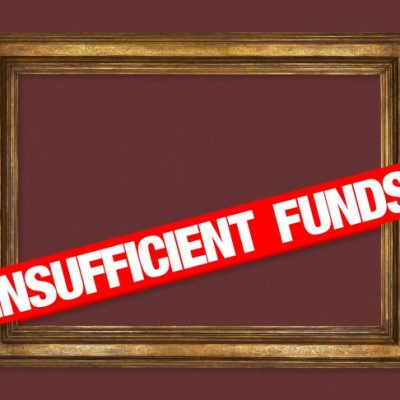In April, the Irish government announced a new strategy: ‘Investing in Our Culture, Language and Heritage 2018–2027’. Astonishingly, although the Irish state has been in existence for almost a century, this is the first long-term plan ever devised for the country’s culture and heritage. For that reason alone, it should be welcomed. Furthermore, the scale of proposed investment in national cultural infrastructure – almost €1.2 billion over the next 10 years – is unprecedented. More money and better planning: it’s not often that either, let alone both, is on offer.
The scheme is one strand of a larger state programme called Project Ireland 2040. Unveiled in February, this was trumpeted by its devisers as being ‘the Government’s overarching policy initiative to make Ireland a better country for all of us, a country that reflects the best of who we are and what we aspire to be.’ Ireland may be a small country, but her politicians like to think big.
Accordingly the schedule for investment in culture and heritage, outlined in a smart 70-page document, is being promoted as a statement of their significance to ‘how we live and the kind of society we want to create for our children and grandchildren’. One trusts future generations will appreciate the efforts being made to better their cultural welfare over the coming decade, but they may also need to have explained to them why what has been achieved during that time has been limited in scope.
While €1.2 billion sounds like an impressive sum, some context ought to be provided. In the first place, for all that Ireland likes to proclaim its unquestionably impressive cultural credentials, state spending in this area has been consistently and shamefully low. According to the most recent figures available from Eurostat (for 2016), at 0.2 per cent of GDP Ireland’s expenditure on cultural services is one of the lowest within EU member states. The money promised over the coming decade will make some difference to that, but is not enough to raise the country much higher in the league table of national cultural spend. When €1.2 billion is broken down over 10 years it equates on average to an annual additional outlay of €120 million.
That money will be spread over a lot of ground, because the 2018–27 programme has a extraordinarily wide brief. It ranges from the maintenance and upgrading of the country’s outdoor cycling and walking trails to ambitions to ‘restore and conserve the biodiversity of our rich landscape for the benefit and well-being of all’. Also included is better provision for the Irish language, including its promotion as the community language of the Gaeltacht (regions of the country where Irish is primarily spoken) through what is described as ‘investment in physical infrastructure supporting the statutory language planning process.’
In terms of how it is more commonly understood, ‘culture’ will receive a generous slice of the proposed €1.2 billion. Between them, nine national cultural institutions will benefit to the tune of €460 million while a further €40 million will be invested in local arts and culture infrastructure nationwide. Galway, which is due to be European Capital of Culture in 2020, will receive €15 million and another €10 million will be spent on the digitisation of national collections. Some €200 million has been allotted to ‘investment in media production and audio visual industry’, which essentially means encouraging more international film and television companies to work in Ireland: studios in Dublin and elsewhere look with envy over the border to Northern Ireland where, thanks to tempting tax breaks, popular series such as Game of Thrones have been filmed.
The bulk of this funding, that €460 million cake, also has to be sliced up and served across the course of a decade. Plans have already been announced for a pedestrian link between Dublin’s Natural History Museum on Merrion Square and the National Museum of Ireland’s main premises on Kildare Street. The latter’s second site on the quays in the former Collins Barracks is to install new galleries dedicated to science and world cultures. However, the greater part of expenditure will be on essential refurbishment work necessitated by previous state neglect. For example, 11 years ago a staircase in the Natural History Museum collapsed; since subsequent safety concerns were not addressed the upper balconies of the building have never reopened. Similar tales can be told throughout the sector. While large parts of the National Gallery of Ireland recently benefited from an extensive and rightly praised restoration programme, substantial parts of the site were left untouched and still await a makeover. Together with a chronic shortage of staff, they have led to weaker engagement with visitors and shorter opening hours; the National Library of Ireland is typical in having only one-third of the numbers employed by its equivalents in Wales or Scotland. So a small amount of the money will go on fresh strategies, but a lot on resolving infrastructural problems that ought to have been sorted out sooner.
Aside from the €200 million committed to boosting film and television production, what assistance is proposed over the same period for those currently engaged in creative work? This is where things grow more complicated, thanks to another government initiative called Creative Ireland. To understand its origins, one must go back to 2016 when the country marked the centenary of the Easter Rising, an occasion acknowledged as the start of Ireland’s successful struggle for independence. Fraught with potential pitfalls, the anniversary was handled with considerable skill in ceremonies and events across the country that were respectful, inclusive and engaging. Credit was rightly given to the Department of Culture, Heritage and the Gaeltacht, responsible for overseeing the commemorations.
This positive response gave the department, frequently the subject of public criticism, a deserved fillip. But it also resulted in what looks like a sudden rush of blood to the head. Before the end of 2016, the department announced the establishment of a new body called Creative Ireland – presented as a five-year initiative to build on the success of that year’s events. The document issued to announce the birth of this entity grandiosely proclaimed the Creative Ireland programme as ‘an invitation to the entire country to get involved in something truly inspirational’. It went on: ‘At its heart is collaboration – between central and local government, between culture and industry, between artists and policy makers – to facilitate an ecosystem of creativity.’ And on: ‘The transformational potential of culture was understood by the revolutionary generation. During 2016, as we commemorated the events that led to the foundation of our state, we rediscovered the power of cultural creativity to bring communities together, and to strengthen our sense of identity…’
What appears to have escaped the notice of government mandarins was that an organisation to encourage nationwide creativity already exists: the Arts Council, which they have funded annually since 1951. The latter was understandably perturbed by the appearance of what could be considered as a rival funding body, especially since the government then proceeded to provide €5 million for Creative Ireland’s first year in operation. Furthermore, in 2018 Creative Ireland received a larger percentile increase in funding than the Arts Council (their respective grants for the year are €8.5 million and €68.2 million). This confirmed the suspicions of conspiracy theorists that the younger organisation is, at least in part, intended to undermine the older one, which has always operated independently of central government (at times much to its chagrin). ‘The relationship between Creative Ireland and political power appears to be a close one,’ an editorial in the Irish Times stated after the budgets were revealed in October 2017.
Other than cheerily spending the money allocated to it, quite what Creative Ireland does remains something of a mystery. With a director, Tania Banotti, who was previously for five years chief executive of the Institute for Advertising Practitioners in Ireland, the new organisation has certainly proven adept at marketing itself: last year more than €1.2m of the budget went on self-promotion, including €760,000 on media advertising, €330,000 on social media and €192,000 on website development (according to figures released following a Freedom of Information request by Sinn Féin). Much smaller amounts, in the region of €10,000–€20,000, were disbursed to diverse events around the country, almost all of them already in receipt of Arts Council largesse.
In addition, there were one or two rather surprising beneficiaries of Creative Ireland funding: the Kinsale Sharks Awards, which is actually an annual advertising jamboree, was given €10,000. The most substantial amount, more than €1.1million, went on Cruinniú na Cásca, which took place on Easter Monday in 2017 and was heavily publicised as ‘an annual free festival which aims to celebrate culture and creativity in contemporary Irish society.’ Oddly, Cruinniú na Cásca did not take place over Easter 2018. Instead, another nationwide, day-long festival, Cruinniú na nÓg – aimed at children and young people – is being organised by Creative Ireland for 23 June. It remains to be seen whether this event proves to be more annual than its predecessor.
The apparent want of strategic coherence, except when it comes to self-marketing, has not helped Creative Ireland win widespread support: writing in the Irish Times last October, the Arts Council’s deputy chair John McAuliffe described the upstart organisation as ‘part-car, part-temple, part-group-hug and part-energy-drink’. But there are more serious issues at play here, not least regarding transparency and accountability. The process whereby Creative Ireland has allocated funds is not clear. Giving money to organisations already supported by the Arts Council suggests a want of real purpose – other than to encourage devotion to the present government.
And therein lies the essence of the problem regarding both Creative Ireland and the recent cultural funding announcement. In both instances, the suspicion lingers that these are little more than marketing strategies designed to make Ireland’s current political masters look good. If the state simply wished to encourage greater creativity among citizens, perhaps by hosting an annual day devoted to the arts, it could have provided the Arts Council with greater resources. Similarly, the government might have addressed the defects in the national institutions for which it is responsible without calling press conferences or issuing glossy brochures. Ireland’s current taoiseach (prime minister), Leo Varadkar, has regularly been berated for prioritising style over substance, and communication over content. That would appear to be the case with regard to this division of his government. In the Department of Culture, Heritage and the Gaeltacht, is creativity mostly being exercised on the culture of spin?
From the June 2018 issue of Apollo. Preview and subscribe here.



